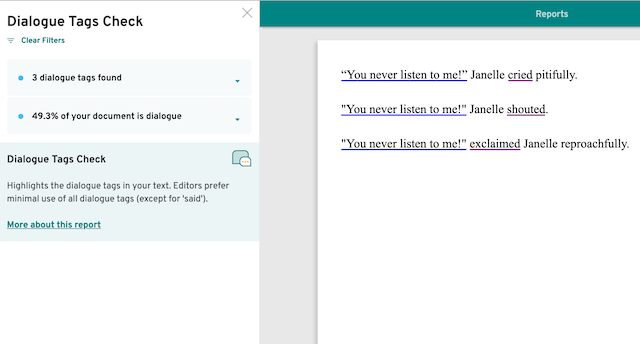
Dialogue serves many purposes in writing, especially in fiction. It can advance the plot, supply backstory, and show characterization.
But dialogue has its own grammatical rules, especially regarding punctuation. Where do the commas go? When do you use dashes? And what is the difference between a dialogue tag and an action beat?
“Have no fear!” the writer said. “I’ll tell you everything you need to know about punctuating dialogue!”
Quotation Marks
You might know that there are both single and double quotation marks. But how should you use them?
In general, American English uses double quotations marks for dialogue, while British English uses single quotation marks.
American English: “Put it in the trash can,” she said.
British English: ‘Put it in the rubbish bin,’ she said.
A common mistake involves where to put the punctuation marks: inside or outside the quotation marks. At the end of dialogue, punctuation marks such as periods, question marks, exclamation points, commas, and ellipses always go inside the quotation marks, as per the examples above.
Quotes inside of dialogue might seem tricky. But all you have to do is alternate between single or double quotation marks, like these examples:
American English: “He said ‘I love you’ last night,” James said.
British English: ‘He said “I love you” last night,’ James said.
You should always close your quotation marks, unless your dialogue continues into the next paragraph without a dialogue tag or action beat. In that case, do not close the quotation marks until the character is done speaking, but open each new paragraph with new marks. For example:
The king said, “We are not going to lose this war. We will do everything in our power to defeat the invaders. We have heart, but they do not.
“Bring everyone inside the gates. Have the blacksmiths forge as many weapons as possible. Ration the food to last through a long siege, and recruit any able-bodied citizen to fight.”
Dialogue Tags
Dialogue tags are phrases that show who is speaking and how. They are simple phrases that include a noun, proper noun, or pronoun and some variation of the word “said.” Dialogue tags have specific rules for punctuation.

If the dialogue tag comes after the dialogue, you will use a comma inside the quotation marks and you’ll start the dialogue tag with a lowercase letter (except in the case of proper nouns).
- “I don’t know what you mean,” the man said.
- "Sounds like good advice,” Kate said.
If the dialogue ends with a question mark or exclamation point in the quotation marks, you will still begin the dialogue tag with a lowercase letter. You will always end a dialogue tag, even if it contains another clause, with a period.
- “What is that?” the police officer asked.
- “Congratulations!” my mother exclaimed with a smile.
- “Are you serious?” Vicky asked, raising her eyebrow.
If the dialogue tag precedes the dialogue, the comma goes before you open the quotation marks. The first word of the dialogue inside the quotes should be capitalized.
- Dan said, “I hate that guy.”
- She opened the window and yelled, “Go away! Leave me alone!”
- Casey asked, “When is the meeting?”
But what if the dialogue continues after the dialogue tag? It depends on whether your tag goes between two sentences or in the middle of one. If the dialogue tag separates two complete sentences, place a period after the dialogue tag and start the next sentence with open quotes and a capital letter.
- “I can’t believe he’s gone,” Jerry whispered. “I’ll miss him.”
- “Do you love me?” Mary asked, tears in her eyes. “Because I love you.”
However, if the dialogue tag breaks a sentence in half, put a comma after the tag, then open the quotation marks with a lowercase letter (unless it is a proper noun).
- “Listen, Linda,” Mr. Graves said, “you’ve done a great job, but I have to let you go.”
- “I’ve got eggs, milk, chicken, and,” my mom said with a wink, “mint chocolate chip ice cream for tonight.”
Using ProWritingAid’s Dialogue Check
The most common dialogue tags are “said” and “asked.”
In fact, using other dialogue tags like “shouted” or “squealed” will brand you as a novice. And it’s worse if you add an adverb.
Dialogue is one of many areas where ProWritingAid can help your writing shine. With the Dialogue Check, you can learn instantly what dialogue tags you’ve used and where to find them.

This helps you determine if you’ve used appropriate tags, if you shown rather than told, and if it’s clear who’s speaking.
Find out how you’re using dialogue tags with ProWritingAid.
Action Beats
Action beats are a great way to identify who is speaking without the repetition of he said, she said. They can show action or emotion and many other elements in a scene. However, they have different rules for punctuation.
Action beats are standalone sentences without a version of “said.” Therefore, you do not use commas to connect them with dialogue. In fiction, you will generally always end an action beat with a period, although some authors may use exclamation points on rare occasions.
- She shook her head. “No, I have never seen him before.”
- “Stop! What are you doing?” The teacher rushed across the classroom.
- “I love you, too.” Michael grinned and leaned in for a kiss.
But what if you use an action beat to interrupt dialogue? If you separate two complete sentences, you will simply place the action beat as its own sentence between two sets of quotes.
- “I never said he could go to the concert.” Linda sighed and sat in her chair. “He lied to you again.”
If you use an action beat to break up a sentence, you will use an em dash after you close the first set of quotation marks and immediately before you open the second set. Also, this action beat will not start with a capital letter unless it begins with a proper noun.
You can access the em dash with the keyboard shortcut Alt + 0151, or Option + Shift + Hyphen on Mac. Never put a space on either side of an em dash.
- “And before we knew what was happening”—my boyfriend leaned forward with a gleam in his eye—“the lights went out, and music started blaring.”
- “Do you really think”—Jack looked around to make sure no one was listening—“that Charles is behind this?”

Breaking Off Dialogue
There are two ways you can show that dialogue has broken off before the character completes their thought. The first is by using the em dash again, although this time it goes inside the quotation marks.
- “What the—” The mysterious figure hit Jim over the head, knocking him out cold.
- “I can’t believe—” Frances put her hand up to cut me off.
If the character later continues what they were saying, you can start the new dialogue by placing an em dash after the new set of quotes.
“I can’t believe—”
Frances put her hand up to cut me off, but I pushed it away. “—that you are so rude!”
But if your character’s speech isn’t interrupted and instead trails off, you can use an ellipsis. The ellipsis contains three periods in a row—never more, and never less. Depending on your style guide, you may place spaces between each dot. The ellipsis will go inside of the quotation marks.
- “I don’t know but…”
- The queen wiped her eyes. “He told me he would be back before…”
Other Dialogue Rules to Consider
Whenever the speaker changes, start a new paragraph. This helps prevent your readers from being confused about who is saying what. Always make sure that your dialogue tags and action beats provide clarity about who is speaking, as well.
Internal dialogue can be trickier. Your readers will get confused if you use quotation marks for both internal and external dialogue, although it isn’t technically incorrect. Some authors use italics for internal dialogue, while others don’t use quotation marks or italics, and instead just use thought tags (e.g. he thought, she mused). The choice is yours.
What is your biggest challenge when it comes to writing dialogue? Let us know in the comment section.

